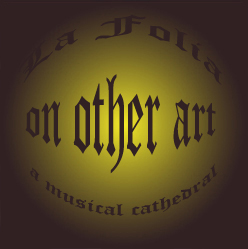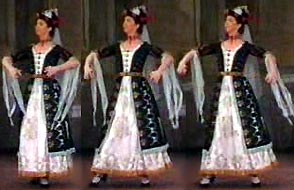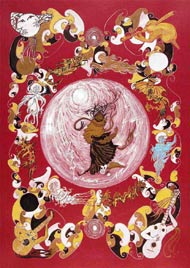

 |

|

 |
On the left side there are the separate variations in ceramics in a study with the sheet music. On the right side every variation of Vivaldi's Folia, making it full circle, are put on top of each other and are displayed in bars. The most obvious distortion is the loud ending of every variations in the final chord of a variation, where the sound is stopped to start a new variation. |
 |

01- Introduction by Wim Simons, Publisher 'De Beuk', Amsterdam
02- Aria and variation no. 1 fromt Corelli's sonata op.5-12 “La Follia
“ duration: 1’27’’
03- Poem: Mijn kleine drenkplaats
04- Corelli's variations 12 and 13, duration: 0’42’’
05- Poem: Magnolia
06- Corelli's variations 19, 20 and 21, duration: 1’48’’
07- Poem: Cactussen
08- Corelli's variations 9 and 10, duration: 0’30’’
09- Poem: Herdenken (watersnood 1953)
10- Corelli's variations 14, 15 and aria, duration: 2’26’’
11- J.S.Bach: Adagio from sonata for violin solo nr. 1 BWV 1014, duration:
2’58’’
12- Poem: Je wintert niet over
13- J.S.Bach: Sarabande sonata for violoncello solo nr. 5 BWV 1011 duration:
1’44’’
14- Poem: Herbegraving
15- J.S.Bach: Andante from sonata for violin solo nr. 1 BWV 1014 duration:
3’03’’
16-22 Intermezzo : 3 quatrains alternated with Corelli's variatons 6, 7,
8 and 4 duration: 4'03"
23- Poem: Rioolbuizen
24- J.S.Bach: part one sonata in F BWV 1021 duration: 3’02’’
( viola d’amore , organ and violoncello)
25- Poem: Massage
26- J.S.Bach: part two sonata in F BWV 1021 duration: 1’47’’
27- Poem: Gulzigheid duration: 1’11’’
28- J.S.Bach: deel IV sonata in F BWV 1021 1’47’’
29- J. Nozeman (1693-1745): Allegro from first sonata for violin in E (violin,
harpsichord and violoncello) duration: 2’19’’
30- Poem: Laatste schooldag 1
31- Nozeman: Adagio from sonata for violin duration: 0’25’’
32- Poem: Laatste schooldag 2
33- Nozeman: Vivace from sonata for violin duration: 1’32’’
34- Epilogue by Wim Simons

 |
Duration: 1'56", 4896 kB in wmv-format, at the
Dance-site http://www.dancilla.com/
© 1995 Tönnheims Förlag, used with permission Thanks to Mario Herger (http://www.volkstanz.com/ & http://www.dancilla.com) for making this clip available |

 |
Duration: 0'40", 1829 kB in wmv-format, at the
Dance-site http://www.dancilla.com/
© 1995 Tönnheims Förlag, used with permission Thanks to Mario Herger (http://www.volkstanz.com/ & http://www.dancilla.com) for making this clip available |

Follía by Voices of Music
and in a choreography by Carlos Fittante |
In 1705, eager to make his mark as a composer of both opera and instrumental music, the young Vivaldi published his first set of twelve trio sonatas as Opus 1. The last sonata, which is a highly virtuosic set of variations on the "La Follia" dance pattern (titled only "Follia" in the print), is one of his most famous works; Vivaldi takes Corelli's variations on the same theme-and-bass pattern from Corelli's Opus 5 (1700), which was already a famous work, and adds figuration of even greater complexity.
 |
Vivaldi: la Follia variations, 2007 |
Abstract art has been difficult to me to do. So i decided to take an abstract subject, music. la Folia is one of my favourites, especially the one by Vivaldi. It was a natural starting point. Variations was something I could depict. I tried to get something of the rhytm and intense. The colors are maybe not Mediterrian enough, I am Scandinavian after all. Working in glass determined much of the solution. Much of the curly and layered baroque texture was not applicable.
 The only reason this book is mentioned here is that the 'later' Folia theme
is mentioned at 30 different pages in the Dutch edition (all references are
made by the Dutch fourth edition February 2005). If you like a mixture
of fiction and non-fiction in a quasi scientific context, if you like intrigues
at the court, if you care for very unlikely events or when you are looking for hopeless
love-relations I guess this book might be worth reading. Otherwise, take my
advice and skip it.
The only reason this book is mentioned here is that the 'later' Folia theme
is mentioned at 30 different pages in the Dutch edition (all references are
made by the Dutch fourth edition February 2005). If you like a mixture
of fiction and non-fiction in a quasi scientific context, if you like intrigues
at the court, if you care for very unlikely events or when you are looking for hopeless
love-relations I guess this book might be worth reading. Otherwise, take my
advice and skip it. Veritas is the follow-up of Secretum in a series of seven books and in this volume too the Folia by Albicastro is mentioned at several occasions: pages 87, 224, 328, 334, 610, 626 and
645 in the Dutch edition 2006 to be exact.The piece serves as a decorum of memories and a dream of one of the main figures and hard to avoid, during a mental breakdown to
pay respect to the literal meaning of the word Folia, madness.
Veritas is the follow-up of Secretum in a series of seven books and in this volume too the Folia by Albicastro is mentioned at several occasions: pages 87, 224, 328, 334, 610, 626 and
645 in the Dutch edition 2006 to be exact.The piece serves as a decorum of memories and a dream of one of the main figures and hard to avoid, during a mental breakdown to
pay respect to the literal meaning of the word Folia, madness.| Danish original text | English translation |
|---|---|
| Kan jeg endnu Folie d'Espagne! Se Her, Folie d'Espagne Folie d'Espagnemed din Fod Ha, ha! Ha, ha Den spas er god Men skont den dolger stolt sit Mod Ak, gode Frue, nok en Folie Folie d’Espagne med din Fod Ak, du dejlige Folie! La-la-la-la - la-la-la-la! Tra-la-la-la - la! |
I'm able to do Folie d'Espagne! Regard, Folie d'Espagne Folie d'Espagne you must stalk Ha, ha! Ha, ha The best has come Behind a veil we hide our mood Ah dear mistress, yet a Folie Folie d’Espagne you must stalk Ah, thou wonderful Folie! La-la-la-la - la-la-la-la! Tra-la-la-la-la - la! |
as recorded by The Danish Radio Symphony Orchestra and chorus conducted by Frandsen, John.



 This release explores the elements that enable us to better understand the historical preservation of dance,
from the academic page to its transformation into a vibrant performance.
This release explores the elements that enable us to better understand the historical preservation of dance,
from the academic page to its transformation into a vibrant performance.
 |
Jasmin Seifried , a student of
|
Explanation of the abbreviations in the program:
FA = Music of Farinelli's Folie with variations
FE = Choreographie of Feuillet's "Folie d'Espagne pour une femme" with variations
FE*= Feuillet's folie demo-couplet in "Chorégraphie...", 1700
1) "Folia-theme" (FA)-Part I: Choreographie (FE - theme) and
castanets: Solo, + baton; Part II: Duo Choreographie in mirror (axis-symmetrie)
and castanets in counterpoint + riq - Intermezzo
2) "Canon" - Var. No 3 (FA) - Choreographie (FE var. I) and castanets:
Part I: canon à 3 voce; Part II: Duo reflected in axis-symmetrie
with solo-chor. from "Couplet de danse sur une air...", see above)
+ snare drum - Intermezzo
3) "Spanish" - Var. No 2 (FA) - Choreographie (FE var. II): Trio
reflected in point symmetrie, Part I: facing inside, P 2: outside of circle;
Castanets Trio-concert - Intermezzo
4) "Menuet" - Choreographie: solo; Solo-castanet-part (and music) in Feuillet
(1700): solo with castanet-ostinato by the duo + riq - Intermezzo
5) " Musical clock" - Var. No 4 (FA) - castanets tacet - Choreographie
(FE var. III) Part I: "baroque" arm movements; P II: soli/duo/trio
- Intermezzo
6) "A-capella" - Variation of the folia-theme only for 4 castanet
players, à 8 voce
7) "Irish" - Var. No 6 (FA) - castanets tacet - Choreographie
(FE var. IV) Part I: solo; Part II: solo with duo in reflected axis-symmetrie
- Intermezzo
8) "Breaks" - Var. No 7 (FA) - Choreographie (FE var. 5) : Trio
unisono; castanet-accents in musical breaks
9) "Pomposo" - Var. No 9 (FA) - Choreographie and castanets (FE*):
Trio unisono; + solo counterpoint of the tar.
Choreography and castanets: The castanet-partitions are based on the very special castanet-technique of that time (which Feuillet demonstrates in a short folie, menuet and chaconne in "Chorégraphie...", 1701) and their complexity is encouraged by Marin Mersenne's proposition, that ballet-masters should compose real "concerts" with castanets for their dancers (in "Harmonie universelle", 1636). Therefore Grenadillo castanets of different sizes ( No 2, 5, 7 and 9 - the smaller the castanets, the higher usually the sound) and pitches (each double-pair in the distance of about a minor third) were used for this ballet. And this is, why not only the arranging of the solo dances for three dancers, but also the castanet-partitions follow the musical composing techniques of that time like contest of solo/tutti, counterpoint, canon- and mirror-technique

My personal story of how I met La Folia and my reaction to this wonderful musical theme, which I expressed in 16 drawings. I present these drawings in a digitale exposition. But my quest for La Folia brought me into the realm of the Early Folia, a fascinating story of the evolution of as succesfull musical form
best viewed at 800 x 600